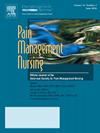Spiritual Suffering in Acute Care Pain Management: A Higher Power Session
IF 1.6
4区 医学
Q2 NURSING
引用次数: 0
Abstract
Background
Most bedside nurses are not aware of the role of hospital chaplains in pain management. This includes the belief that nurses often view chaplains as offering care based on strict religious doctrines. Most nurses view spiritual care to be only associated with emotional well-being. Our recent study described the concept of spiritual suffering and how hospital chaplains provide spiritual interventions. This collaboration may augment pain management in acute care, to improve patient outcomes.
Purpose
This power session describes the implications of nursing around spiritual suffering and the collaboration of nurses and chaplains.
Methods
A pain and spirituality study involving hospital chaplains revealed clinical applications that will be presented. A detailed summary of the data and concepts discovered in this small qualitative study informs new insight into the individual pain experience.
Conclusions
Hospital chaplains’ approach to care is not pastoral or preaching, but as a spiritual counselor and assess spiritual suffering through qualitative assessment. Nurses use well-defined quantitative assessments to describe pain intensity. The collaboration between the two disciplines creates a distinct overlapping of the domains that allows for objectively measured results. These results will be compared to an existential approach to pain assessment. This creates a new theoretical approach to explaining the pain experience.
Implications
Clinical practice implications include collaboration between nurses and chaplains to augment pain management and provide comprehensive spiritual care. Research may include a theoretical approach that includes spirituality and existentialism in the interpretation of the pain experience.
求助全文
约1分钟内获得全文
求助全文
来源期刊

Pain Management Nursing
医学-护理
CiteScore
3.00
自引率
5.90%
发文量
187
审稿时长
>12 weeks
期刊介绍:
This peer-reviewed journal offers a unique focus on the realm of pain management as it applies to nursing. Original and review articles from experts in the field offer key insights in the areas of clinical practice, advocacy, education, administration, and research. Additional features include practice guidelines and pharmacology updates.
 求助内容:
求助内容: 应助结果提醒方式:
应助结果提醒方式:


